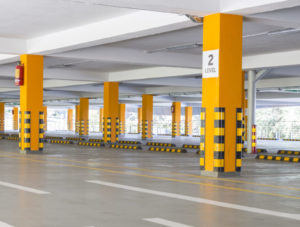Planning and zoning boards all over the United States turn to parking regulations to curtail traffic. It’s been standard practice for decades: any new business, development or construction needs to prove they could meet parking space minimums, utilize off-street parking or may even be required to build new or additional spaces for their real estate projects.
On the surface, it’s a reasonable request: cars get off the street faster when ample parking is made available. The problem, however, is that cars aren’t getting off the street any faster. Circling for parking accounts for up to 30 percent of traffic, as people drive around the block at turtle-like speeds to search for an available space. And that’s after these businesses and residences complied or otherwise accommodated for zoning laws!
One of the reasons for this is that people are still inclined to search for the elusive “perfect” parking spot — something a little closer, something with a little bit of shade. The spots they find aren’t always the ones they want, and so they keep searching, causing backup. Even if parking is plentiful, each person’s perception of the “perfect spot” will keep many circling.
This isn’t exactly a new revelation, but it’s certainly worth discussing once more. For decades, parking experts such as UCLA professor Donald Shoup have theorized that zoning laws don’t adequately address a municipality’s parking problem. According to Shoup, regulations inadvertently spur land use inefficiencies where none existed before, especially relevant as space becomes a precious commodity and car ownership trends downward.
Even more concerning is the false sense of security created by zoning regulations. According to Shoup, parking space minimums have lulled cities into thinking that they solved their traffic problems — after all, the spaces were built and are readily available. However, all it takes is a brief look outside to remind the average driver that traffic simply has not gone away.
So, what’s a municipality to do?
If zoning laws can’t influence traffic and parking, what will?
In short, there’s no one-size-fits-all solution. Each municipality will need to formulate new regulations based on current and predicted needs, existing issues and overall city planning goals.
Take Los Angeles for example. The second-most populous city in the United States is notorious for its dependence on cars, its traffic and the parking necessary to store all those cars. While LA’s public transit system is undergoing a massive expansion, there’s no guarantee that these improvements can change a culture where only 360,000 out of 13 million residents take public transit. New York City, the country’s most populous city, is the complete opposite – only 27 percent commute by car. Despite those challenges, and even though 70 percent of New Yorkers take the subways and buses to work, traffic has not seemed to subside.
Clearly, a solution that would work for LA may not work in NYC and vice versa. However, there are some common areas which any municipality, no matter their demographic makeup or particular parking problem, should consider when discussing zoning law reform:
- Start with examining minimum parking requirements. It’s extremely difficult to judge how many people may visit an event venue, strip mall or art museum by car, but every developer is forced to at high cost. At close to $30,000 per spot, it’s a financial burden and a planning nightmare to factor in a seemingly arbitrary number of spots. There’s even a term for this: engineers call this problem a “kludge,” a clumsy but temporarily effective solution to a problem – a problem that planners have rationalized for decades.
- Addressing curbside parking. Shoup and other researchers have long advocated for changing the pricing of curbside parking. Oftentimes, people will circle for cheaper street parking. At only $1 or $2 per hour, it’s certainly more affordable than the $10, $15 or way higher cost to park in a lot. The result is a traffic buildup as drivers race for those more accessible spots. Shoup argues that municipalities which change curbside parking pricing will encourage drivers to consider parking garages when the block-circling gets tough.
- Installing smart parking technologies. Designed to move cars off the street and into spots – the original intention of these parking requirements — smart parking systems guide drivers directly to open spots. Level guidance systems signal to drivers when to pull in and when to keep moving by indicating the exact number of available spaces on that level. Space guidance systems signify open spaces with green LED lights. These scalable solutions can be retrofitted to any garage or lot, and quick installation means that a solution can be put to work within a few short months.
No matter the right solution for a municipality, changes to the zoning regulations will take significant time. Studies need to be done, recommendations need to be made and public hearings need to be held. However, municipalities can take the time to thorough parking’s role in their traffic woes, determine which zoning regulations are impacting these decisions and move forward with a comprehensive plan to address what’s become a nightmare for commuters everywhere.

